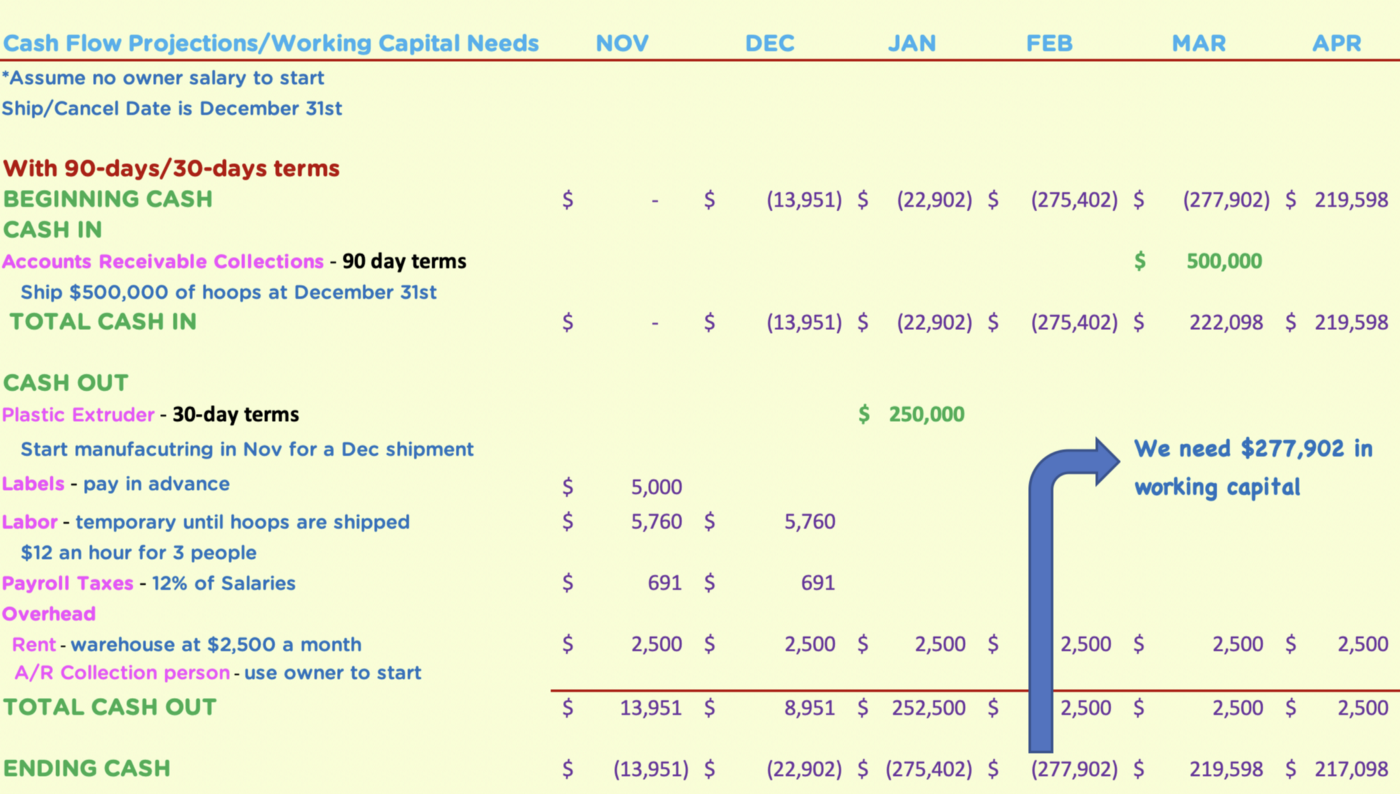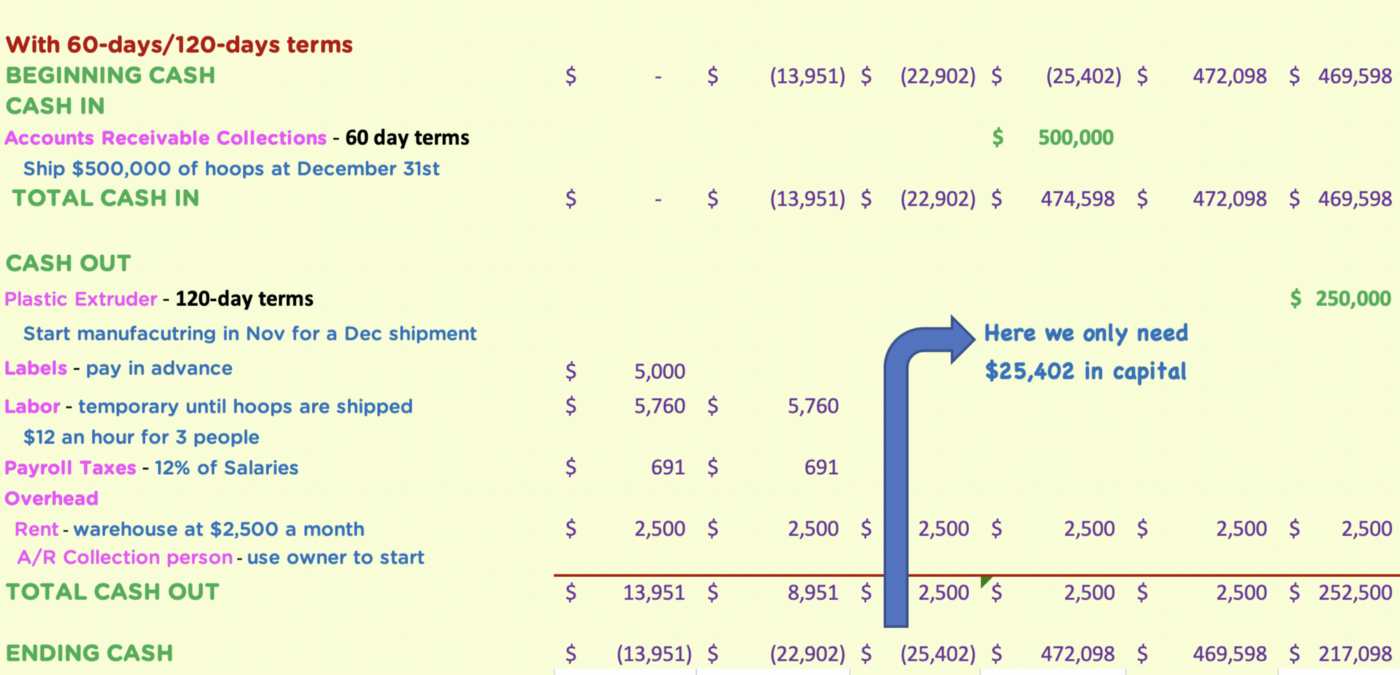|
… even if you are making a profit. Working Capital is the lifeblood for most businesses. It can make the difference between surviving and growing or going bankrupt. Working capital is all about planning, negotiating and timing. Oftentimes, owners learn this the hard way. After leaving the investment banking world, my then husband and I started our own business. According to family folklore, his father’s plastic manufacturing business had patented the original Hula Hoop which was featured on The Art Linkletter Show and immediately became a worldwide fad, its sales estimated to be over 100 million hoops in two years. After those two years, his family went back to their regular plastic extrusion business for OEM customers like automotive companies and the like. Whamo registered the name and continued selling them, albeit in much lower numbers. At the 50th anniversary of the launch of the original, a cousin asked us to make hoops for their chain of American Greetings stores which numbered about 50 or so. We updated the colors to fluorescent shades and they looked fantastic. We named the hoop the Maui Hoop and called our company Maui Toys. We invented three more products, went to our first trade show, the International Toy Fair in New York City, and our toy company was off and running. Maui Toys was soon selling to large retailers such as Toys “R” Us, Walmart, Target, Kmart, Children’s Palace, and a slew of other smaller chains and independent toy stores. It was great fun, but we were facing a looming working capital problem. We were self funded and it was one thing to make a few thousand hoops for one smallish store chain, and it was another to make hundreds of thousands of hoops for huge chains such as Walmart. Working CapitalBefore I get to our survival strategy, let me explain what working capital is for those who don’t know. It is the money a business needs to cover the gap between paying bills for its manufacturing or purchases of its products and collecting money from the sales of those products. This can pose a problem. Why? Let’s use the example of making hoops. You order your hoops from a plastic manufacturer, in this case a plastic extrusion company. Think of extrusion as the famous Play-Doh machine where you put a ball of doh in the little mechanism, a shape at the end (called a die) and you push the Play-Doh through. It comes out as a long tube of doh in whatever shape you have chosen. Obviously for the hoop a circle die was chosen. Your extruder makes your products and gives you a 30-day invoice which means you have to pay them in 30 days for the plastic tubes. Let’s assume that bill is $250,000. Then you have to pay factory workers for assembling the hoops in a circle with a connection plug, put a label on it, and pack it into a box for shipping and displaying at the store. Your toy company has to pay the factory workers their salary in addition to payroll taxes bi-weekly. You also have to buy a label from a printing company. It’s a small expense but has to be paid up front until you can establish a credit relationship with them to get 30-day terms. Let’s say all of that costs roughly $14,000. Most of it has to be paid in 30 days or less. You ship your boxes of hoops to your biggest customer and invoice them. They have 60 days to pay you and you find that they often stretch that out to 90 days and sometimes even 120 days. According to the following, hypothetical and very simplified cash flow/working capital projection, by month 4 you need almost $278,000! That’s assuming your customer pays you in 90 days and you have to pay your plastic manufacturer in 30 days. Timing You’ve had to spend about $280,000. Your invoice to your customer is $500,000. There is a lag effect where you have to come up with almost $280,000 dollars to pay your suppliers and you won’t receive your $500,000 from your customer for another 90 days. That’s a working capital problem. By the way, you’ve just made a huge profit. But, how do you bridge the 60, 90 or 120 gap between paying your bills and receiving your money? Hard to put $280,000 on a credit card. Maui Toys didn’t have that kind of money. Nowadays, founders might raise money as seed capital from an investor and give away a percentage of their company’s stock. We came up with another solution. The number one reason why we were able to survive and grow our business: We asked our plastic manufacturer to accept 120 days for our company to pay their invoice. They said, yes. They gave us 120 days to pay our bills. Technically, they gave us 30 days and we didn’t pay for 120 days. And they didn’t sue us. Or shut us off from future purchases. Labor and other costs still had to be paid for, but they were a relatively small percentage of the overall cost so we were able to cover that ourselves. We were lucky because we didn’t have to give away ownership to get started. In the startup world that’s called bootstrapping it. Increase Your Working Capital
To summarize, these are the steps you can take to increase your working capital.
And remember, the truth is always in the numbers. Originally published at https://www.datadriveninvestor.com on August 10, 2022.
0 Comments
Leave a Reply. |
Stories and snippets of wisdom from Cynthia Wylie and Dennis Kamoen. Your comments are appreciated.
Archives
June 2024
Categories |






